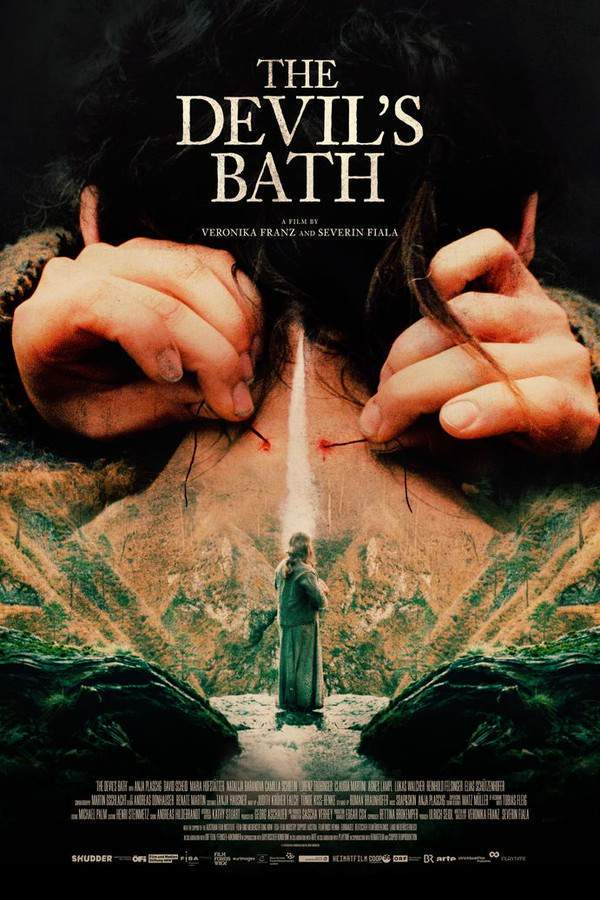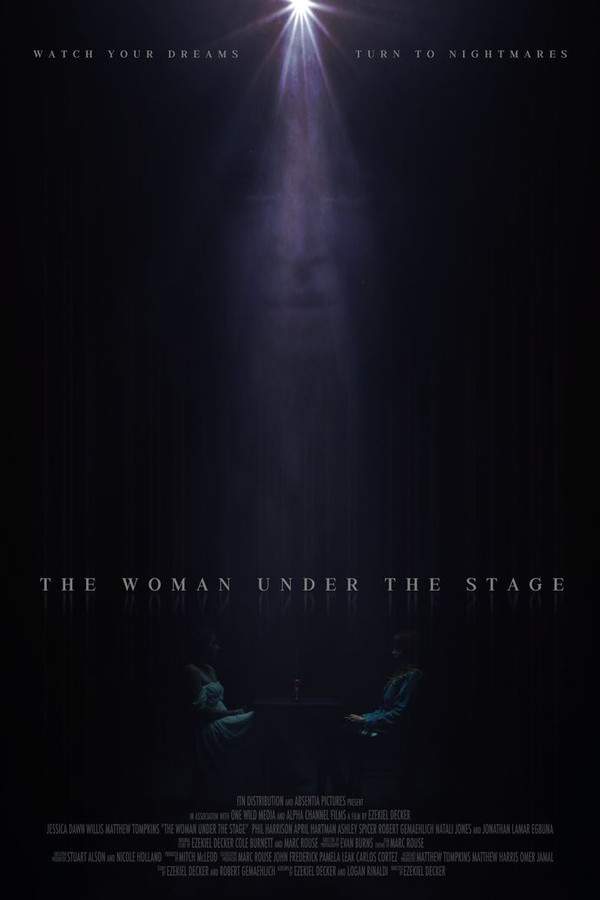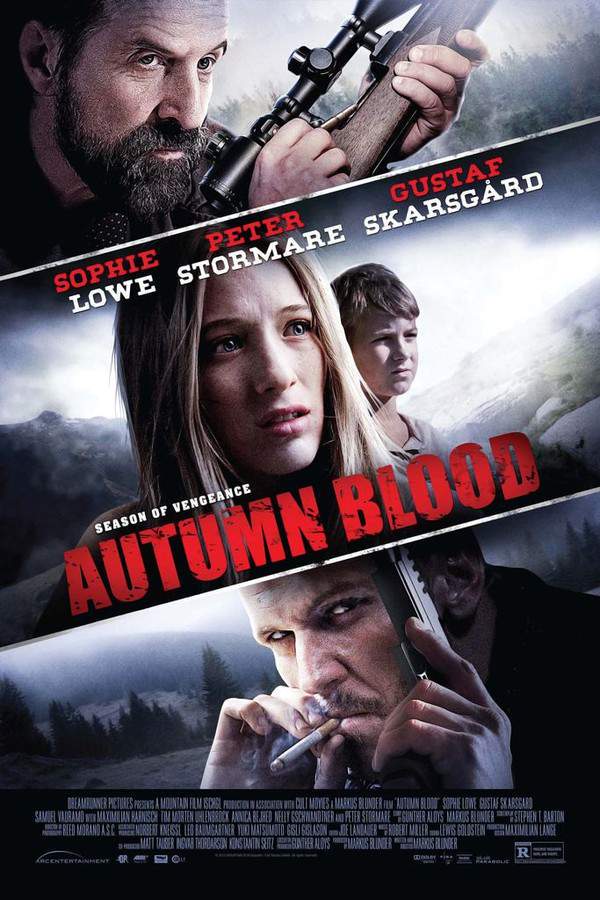
The Devil's Bath 2024
Directed by

Severin Fiala
Test your knowledge of The Devil's Bath with our quiz!
The Devil's Bath Plot Summary
Read the complete plot summary and ending explained for The Devil's Bath (2024). From turning points to emotional moments, uncover what really happened and why it matters.
As the curtain rises, the innocent playtime of a young boy is shattered when his affectionate moment with a distressed infant comes to a sudden halt. Summoned home, he leaves the infant crying alone in its cradle, unaware that an enigmatic woman is about to take charge of a somber situation. This woman feels the heavy mantle of responsibility as she embarks on a perilous journey up a majestic mountain. The cries of the infant gradually fade as she unhooks her rosary from her neck and delicately wraps it around the child’s, signifying a glimmer of hope. At the summit, overlooking a breathtaking waterfall, she stands silently, only to be met again by the infant’s desperate wails. With a heart laden with despair, she makes a harrowing choice, sending the child tumbling down the rushing falls, and solemnly crosses herself, a haunting gesture that underscores the gravity of her actions. Approaching a church-prison tower, she knocks anxiously and confesses to a waiting figure that she has committed an unbearable sin.
As night envelops the scene, the camera shifts to reveal the chilling sight of the decapitated body of the unnamed woman, suspended grotesquely in a chair, portraying the remnants of violence with appallingly severed fingers and toes. An unseen hand methodically cuts away one last finger, wrapping it in cloth—a grotesque memento.
The following morning brings Agnes (Anja Plaschg), whose exuberance in the forest showcases her playful spirit. Singing and frolicking with insects, she gathers flowers and berries to beautify her hair. However, her mother and brother remind her that she must prepare for her upcoming wedding to Wolf (David Scheid). As the family sets out on their journey through the woods, they arrive in town for a jubilant celebration of their union, where the villagers hoist Agnes in jubilant cheer. This moment of bliss is fleeting, as the men partake in disturbing festivities involving blindfolded contestants competing to slaughter roosters with oversized sticks.
In a moment of intimacy, Wolf leads Agnes away from the jubilation to reveal their wedding gift: a mysterious house. What initially fills Agnes with joy soon turns to trepidation as she realizes the closeness to Wolf’s mother and their financial struggles. Despite her worries about the loan taken out for the house, Wolf reassures her that he will pay it back by harvesting lumber, leaving Agnes in a state of uncertainty about their future.
That night, as the town revelers indulge in drunken celebration, Agnes finds herself face-to-face with Wolf, who is excessively intoxicated and reveals more than just admiration from his best friend Lenz, as they stumble through the chaos. Seeking to help, Agnes offers to clean, but is firmly denied the privilege on her wedding night. Meanwhile, her own family gifts her the severed finger of the woman whose story began the narrative—a token Agnes decides to conceal beneath her mattress in hopes of invoking the blessing of motherhood.
As the night progresses, drowning in drunkenness and wild behavior, Wolf collapses into bed, leaving Agnes alone in her thoughts. With a quest to find him the next morning, she meets a kind woman and her children who promise to guide her to the fishing pond, yet they mysteriously disappear, leaving Agnes feeling lost.
Searching through the woods and following a peculiar drawing attached to a tree, she comes upon the lifeless body of the woman—the image hauntingly echoing the film’s beginning. Later, as Agnes laboriously helps dredge the pond with Wolf and his demanding mother, tension grows, particularly as she faces criticism for her less-than-stellar performance.
Time drifts by in a blur of mounting challenges as Agnes faces continual rebuke from Wolf’s mother, struggles to find her footing during a chaotic lunch, and attempts to adjust to her new domestic life. Despite her resolve, her efforts to align with Wolf’s routine are met with frustration, and her sense of alienation deepens. Engulfed in her sorrow, she becomes withdrawn, all while navigating the oppressive atmosphere of her turbulent marriage, foreshadowed by Lenz’s tragic suicide and the priest’s venomous sermon condemning such despair.
Days roll into weeks, and Agnes finds herself meticulously crafting a disturbing bond with the headless corpse at the waterfall, singing hymns until dawn breaks. Her family, filled with concern, urges her to return home, trying desperately to reconnect with the sister they once knew. The weight of her isolation grows heavier as crops perish and financial despair grips the family.
In a twisted turn of fate, she stumbles upon an abandoned baby, and despite the protest from Wolf’s mother, she insists on raising the child. Desperation drives Agnes to where she resorts to rat poison, battling waves of physical agony, and pleading with Wolf for spiritual guidance. However, when he returns without help, a tumultuous confession of her suicide attempt ensues, leading to a fateful return to her family, where an elaborate lie about her actions unfolds.
Days later, as the darkness deepens within, she encounters a group of children and offers a prayer in exchange for their help. In a jarring moment of desperation, she fatally wounds a boy, eerily mirroring her earlier heinous act. Haunted and unrepentant, she again confesses at the church-prison tower, seeking absolution.
Agnes’s subsequent incarceration leads to a heart-wrenching confession where she admits to her weariness of life and her grim intention. Granting her forgiveness, the priest unknowingly releases a storm of emotions within Agnes, who spirals into uncontrollable laughter.
Eventually, the somber reality unfolds as Agnes lies motionless, draped in animal hides, the executioner hovering ominously over her. In one fragile moment, she manages to summon a melody, only to have her life abruptly snuffed out with a single swing of the sword. The chaos that follows is a grotesque celebration of death, as the townsfolk engage in a revelry that starkly contrasts with the tragedy of Agnes’s fate, displaying her lifeless body as part of a horrific and mindless festivity.
The Devil's Bath Timeline
Follow the complete movie timeline of The Devil's Bath (2024) with every major event in chronological order. Great for understanding complex plots and story progression.
A Boy's Innocent Playtime Disturbed
The story begins with a young boy enjoying a carefree playtime filled with joy. This moment is shattered when he is summoned home, leaving a distressed infant alone in its cradle without understanding the weight of the situation unfolding around him.
An Enigmatic Woman Takes Charge
An enigmatic woman steps in amidst the chaos surrounding the crying infant, stepping into a role filled with heavy responsibility. She embarks on a perilous journey up a majestic mountain, seeking to address the infant's desperate cries.
A Rosary of Hope
At the mountain summit, overlooking a breathtaking waterfall, she wraps her rosary around the infant's neck, symbolizing a flicker of hope in an otherwise somber situation. However, her actions soon take a harrowing turn as she faces a cruel decision.
A Heartbreaking Choice
With a heavy heart and overwhelming despair, the woman takes the momentous step of sending the child tumbling down the rushing falls. This act triggers her moment of deep regret as she crosses herself before seeking solace.
Confession of Sin
Approaching a church-prison tower, the woman knocks anxiously and confesses to a waiting figure about her unbearable sin. This marks a critical point in the narrative, showcasing her remorse and the weight of her decision.
The Remnants of Violence
The chilling aftermath reveals the decapitated body of the unnamed woman, suspended grotesquely in a chair. The image highlights the violence and turmoil that envelops the story, including a hand methodically cutting away her last finger.
Agnes's Playful Spirit
The narrative shifts to Agnes, whose exuberance in the forest showcases her carefree nature. Collecting flowers and berries, her joy is cut short as her family reminds her of the approaching wedding to Wolf.
Celebration of Union
Agnes and her family arrive in town, greeted by jubilant villagers celebrating her union with Wolf. However, the festive atmosphere quickly darkens as disturbing events unfold, with men engaging in unsettling competitions involving roosters.
A Mysterious Wedding Gift
In an intimate moment away from the celebration, Wolf presents Agnes with a mysterious house as a wedding gift. Initially a source of joy, it becomes a point of concern as Agnes fears the proximity to Wolf's mother and their financial struggles.
The Weight of Expectations
As the wedding night unfolds, Agnes faces the harsh realities of her new life. Wolf's drunken behavior and the familial expectations weigh heavily on her, leaving her feeling isolated and anxious.
A Haunting Gift
Agnes receives a severed finger from her family, a gruesome token connected to the unnamed woman's story. She decides to hide it beneath her mattress, hoping it may bless her with motherhood despite the horror it represents.
The Encounter with the Unknown
The following day, in her quest for Wolf, Agnes meets a kind woman and her children, who offer to guide her. However, they mysteriously vanish, amplifying her feelings of disorientation and loneliness.
The Discovery of Death
Agnes's search leads her to the lifeless body of the woman, an echo of the earlier tragedy that looms over her. This discovery deepens her unravelling psyche, binding her fate with the dark past of the narrative.
Struggles of Domestic Life
As weeks pass, Agnes faces the oppressive reality of her marriage, battling continuous criticism from Wolf's mother. The strain of domestic duties and emotional turmoil leaves her feeling increasingly alienated and hopeless.
A Climactic Descent
In a moment of horrifying desperation, Agnes makes the tragic decision to fatally wound a boy, replicating the act of violence from earlier. This gruesome incident propels her further into a spiral of madness and despair.
The Devil's Bath Characters
Explore all characters from The Devil's Bath (2024). Get detailed profiles with their roles, arcs, and key relationships explained.
Agnes (Anja Plaschg)
Agnes embodies innocence yet is burdened by societal expectations and personal turmoil. Initially filled with joy and love for her upcoming wedding, she quickly becomes engulfed in despair as her life spirals into chaos. Her complex character navigates the darkness as well as fleeting moments of hope, ultimately leading to tragic consequences.
Wolf (David Scheid)
Wolf is portrayed as both a husband filled with affection and a figure struggling under the weight of expectations. His descent into drunkenness and disregard for Agnes's emotional state reveals his limitations and the destabilizing effect of societal pressures on their marriage. Wolf's character signifies the fragility of love when confronted with hardship.
The Enigmatic Woman
The mysterious woman embodies the film's themes of guilt and sacrifice. Her harrowing decision to leave the infant and her subsequent actions underscore the sacrifices made in desperation. She symbolizes the haunting weight of responsibility that ultimately leads to her demise, contrasting sharply with Agnes's path of turmoil.
The Devil's Bath Settings
Learn where and when The Devil's Bath (2024) takes place. Explore the film’s settings, era, and how they shape the narrative.
Time period
The film appears to take place in a timeless rural setting, emphasizing traditional values and community ties. The events reflect a historical perspective on marriage, faith, and societal pressures, suggestive of an era that grapples with innocence and the gravity of choice.
Location
Mountain, Waterfall, Church-Prison Tower, Town, Forest
The movie is set against the backdrop of a majestic mountain and a beautiful waterfall, which serve as symbols of both serenity and chaos. The church-prison tower signifies the presence of authority and moral judgment amidst the unfolding tragedy. The townsfolk's community celebrations juxtapose the dark undertones of the narrative, creating a contrast between revelry and despair.
The Devil's Bath Themes
Discover the main themes in The Devil's Bath (2024). Analyze the deeper meanings, emotional layers, and social commentary behind the film.
😔
Despair
Despair permeates the narrative as characters confront their own sins and the darkness within. Agnes's journey is marked by isolation, haunting grief, and the struggle to find purpose amidst chaos. The theme explores the psychological toll of societal expectations and personal anguish.
🔪
Violence
Violence manifests in both literal and metaphorical forms throughout the film. From the shocking imagery of a decapitated body to the brutal rituals within the townsfolk, the film probes the desensitization to brutality and how it intertwines with moments of joy. Agnes's violent actions reflect the deeper moral decay present in the community.
🕊️
Hope and Redemption
Amidst the despair and violence, the film subtly introduces glimmers of hope and a quest for redemption. Agnes's bond with the abandoned baby and her relentless search for forgiveness complicate her journey, emphasizing the possibility of renewal even in the face of overwhelming darkness.

Coming soon on iOS and Android
The Plot Explained Mobile App
From blockbusters to hidden gems — dive into movie stories anytime, anywhere. Save your favorites, discover plots faster, and never miss a twist again.
Sign up to be the first to know when we launch. Your email stays private — always.
The Devil's Bath Ending Explained
Unravel the ending of The Devil's Bath (2024) with our detailed explanation. Understand the final scenes, character fates, and unresolved questions.
The ending of The Devil’s Bath is haunting and devastating, reflecting the tragic depths of Agnes’ despair. Throughout the film, Agnes grapples with overwhelming depression, feeling trapped in her bleak life as a peasant woman in 18th-century Austria. Her mental health deteriorates as she faces relentless rejection and neglect—her husband Wolf’s indifference, her mother-in-law’s harshness, and her deep sense of unworthiness. Her longing for a child becomes an obsession, and her increasingly disturbed mental state leads her to desperate acts, including stealing a Holy Infant and consuming rat poison, which hallucinate her into believing she is buried and at peace. Agnes’s feelings of guilt and sin are profound, stemming from her belief that her suffering is a punishment and that she needs to die to escape her torment.
Her final act of murder—the killing of the innocent boy—is motivated by her desire to release herself from this pain and to secure her place in heaven through a form of “suicide by proxy.” She sees her act as a means of purification, believing that through this sin she can achieve an absolution that her faith promises. Her confession to the priest provides a fleeting sense of relief, but it ultimately seals her fate. Agnes’s execution is brutal and symbolic; she is beheaded in front of a superstitious crowd, and her blood is consumed by the community, who see it as a sacred blessing. This ritual highlights the era’s brutal and religiously charged attitudes toward death and sins, emphasizing that Agnes’s own guilt and despair have culminated in a tragic, inevitable end—her sacrifice serving as both a final escape and a symbol of the oppressive societal and religious forces that shaped her life. The ending leaves viewers with a haunting reflection on how mental illness, societal expectations, and religious guilt can drive a person to such a devastating conclusion.
The Devil's Bath Spoiler-Free Summary
Discover the spoiler-free summary of The Devil's Bath (2024). Get a concise overview without any spoilers.
In the mist‑shrouded valleys of 18th‑century Austria, a tight‑knit village clings to its traditions while the surrounding wilderness looms with quiet menace. The world is rendered in stark, natural colours—craggy mountains, rushing waterfalls, and dimly lit chapels—creating a landscape that feels both timeless and suffocating. A lingering sense of reverence for the land is matched by an undercurrent of unease, as whispered superstitions and rigid social expectations shape every interaction. The film’s tone is that of an austere folk‑tale, where beauty and dread coexist in the same breath of alpine air.
At the heart of this world is Agnes, a young woman poised on the threshold of marriage and adulthood. Her optimism and yearning for a simple, happy life are palpable, yet she is soon confronted with a hidden truth that begins to erode the foundations of her seemingly idyllic existence. Beside her stands Wolf, her betrothed, whose confidence masks an uneasy dependence on family obligations and the weight of a fragile livelihood. Together they navigate a community where the lines between duty, devotion, and personal desire are increasingly blurred, and where every gesture carries the potential for both comfort and condemnation.
As the village’s rituals and expectations press inward, Agnes finds herself caught in an ever‑tightening web of guilt and despair, forced to grapple with questions that have no clear answer. The atmosphere is thick with moral ambiguity; the right path is indistinguishable from the wrong, and each choice reverberates through the tight social fabric. The film invites viewers to linger in this unsettling ambience, feeling the pull of tradition and the sting of secret revelations, while the mountains and the ever‑present water echo the inner turmoil that threatens to consume her.
Can’t find your movie? Request a summary here.
Movies with Similar Twists and Themes
Uncover films that echo the narrative beats, emotional arcs, or dramatic twists of the one you're exploring. These recommendations are handpicked based on story depth, thematic resonance, and spoiler-worthy moments — perfect for fans who crave more of the same intrigue.
Featured on this page

What's After the Movie?
Not sure whether to stay after the credits? Find out!
Explore Our Movie Platform
New Movie Releases (2025)
Famous Movie Actors
Top Film Production Studios
Movie Plot Summaries & Endings
Major Movie Awards & Winners
Best Concert Films & Music Documentaries
Movie Collections and Curated Lists
© 2025 What's After the Movie. All rights reserved.













